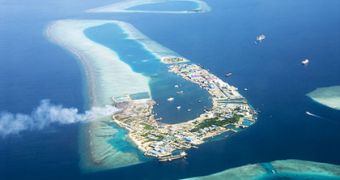The Maldives Islands are made of 26 atolls, placed southwest of the island of Ceylon. The islands were lusted for by the Portuguese and Dutch, but also by the pirates of the Malabar Coast (western India). During the 17th century, the islanders put themselves under the protection of Ceylon, and later, in 1887, under that of the United Kingdom. Finally, the islands won their independence in 1945.
Nowadays, the Republic of Maldives has about 300,000 inhabitants settled on the 1,192 islands and islets which have a total surface of 298 square km (115 square mi). Racially, most of the settlers are at their origins Indians, and most of them Muslims. Even if they resemble the Sinhalese (people of Ceylon) in look and clothing, they are more peaceful and speak a different language. The islands are inhabited at least from the 3rd century BC, and Islam entered the archipelago around 1153.
The Maldives are famous for their reef corals. Atolls are ring-shaped corral-made islands which harbor a lagoon in the center. The largest island atoll is Kwajalein (Marshall Islands, Central Pacific): the island measures 283 square km, encircling 2,850 square km. But the Great Chagos Bank (500 km (310 mi) south of Maldives) forms the largest atoll structure in the world, encircling 13,000 square km, even if it forms only islets that barely measure 4.5 square km. Maldives are famous for their places of scuba diving.
Half of the population of the islands live from fishing, while the other main industry of the island being the production of copra (dried kernel of coconut). The workmanship sector is also well developed, as the people manufacture from straw mats to collars and small objects made of coral and mother-of-pearl.
The main airport of Maldives is Hulule, whose take-off run starts and ends over the ocean. The capital is Male, with its white streets, mosque and museum.

 14 DAY TRIAL //
14 DAY TRIAL //